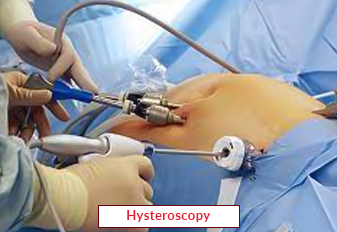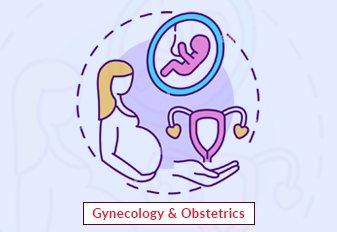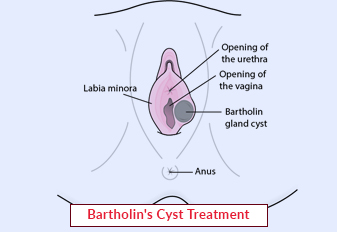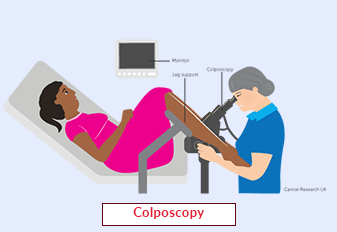Hysteroscopy

Hysteroscopy is a minimally invasive medical procedure that allows healthcare providers to examine the inside of the uterus using a thin, lighted instrument called a hysteroscope. This article aims to provide an overview of hysteroscopy, including its purpose, procedure, and potential benefits.Hysteroscopy is a diagnostic and therapeutic procedure performed to visualize the uterine cavity and diagnose or treat various uterine conditions. The hysteroscope is inserted through the vagina and cervix into the uterus, providing a direct view of the uterine lining.
Book an Appointment
About Hysteroscopy
The primary purposes of hysteroscopy include:
-
Diagnosing and evaluating uterine abnormalities or conditions such as polyps, fibroids, adhesions, or uterine septum.
-
Investigating the cause of abnormal uterine bleeding, including heavy or prolonged menstrual periods or bleeding between periods.
-
Identifying the cause of infertility or recurrent miscarriages.
-
Guiding the removal of abnormal growths, such as polyps or fibroids.
-
Assisting in certain sterilization procedures, such as tubal ligation.
Hysteroscopy allows healthcare providers to visualize the uterus directly, making it a valuable tool for diagnosis and treatment planning.
Conditions and Symptoms that May Require Hysteroscopy
Hysteroscopy may be recommended for individuals experiencing the following conditions or symptoms:
-
Abnormal uterine bleeding: Hysteroscopy can help identify the cause of heavy or irregular menstrual bleeding or bleeding between periods.
-
Infertility or recurrent miscarriages: Hysteroscopy may be performed to evaluate the uterine cavity and identify any abnormalities that could contribute to fertility issues or miscarriages.
-
Uterine abnormalities: Hysteroscopy can detect and diagnose conditions such as polyps, fibroids, adhesions (Asherman's syndrome), or uterine septum.
-
Unexplained pelvic pain: In some cases, hysteroscopy may be used to investigate the cause of chronic pelvic pain.
If you experience any of these conditions or symptoms, consult with a healthcare provider to determine if hysteroscopy is appropriate for you.
Types of Hysteroscopy
There are two main types of hysteroscopy:
-
Diagnostic hysteroscopy: This type of hysteroscopy is primarily used for diagnosis and evaluation of uterine abnormalities. It involves the insertion of a hysteroscope to visualize the uterine cavity and identify any potential issues.
-
Operative hysteroscopy: Operative hysteroscopy is a more advanced procedure that not only allows visualization but also enables surgical interventions. It involves using specialized instruments through the hysteroscope to perform treatments such as removing polyps or fibroids, resecting adhesions, or correcting uterine abnormalities.
The type of hysteroscopy recommended will depend on your specific situation and the purpose of the procedure.
Preparation for Hysteroscopy
Before undergoing hysteroscopy, your healthcare provider will provide specific instructions to prepare for the procedure. This may include:
-
Emptying your bladder before the procedure.
-
Taking medications as prescribed, such as antibiotics or pain relievers.
-
Avoiding food and drink for a specific period before the procedure, if necessary.
It is important to follow these instructions carefully to ensure a successful and safe hysteroscopy.
Procedure of Hysteroscopy
Hysteroscopy is typically performed as an outpatient procedure and does not require an overnight hospital stay. The procedure generally involves the following steps:
-
Anesthesia: Hysteroscopy can be performed using general anesthesia, local anesthesia, or no anesthesia, depending on the complexity of the procedure and individual preferences. Your healthcare provider will discuss the best option for you.
-
Insertion of the hysteroscope: The hysteroscope, a thin and flexible tube with a light and camera at the end, is inserted through the vagina and cervix into the uterus. Carbon dioxide gas or a saline solution may be used to expand the uterine cavity, allowing for better visualization.
-
Visualization and evaluation: As the hysteroscope is gently moved within the uterus, images are transmitted to a monitor, providing a clear view of the uterine lining. Your healthcare provider will carefully examine the uterus and note any abnormalities.
-
Surgical interventions (if applicable): If operative hysteroscopy is performed, specialized instruments may be used to remove polyps, fibroids, or adhesions, or to correct uterine abnormalities.
-
Completion and recovery: Once the procedure is complete, the hysteroscope is removed, and you will be taken to a recovery area to rest and recover from the effects of anesthesia, if used.
Potential Risks and Complications of Hysteroscopy
While hysteroscopy is generally a safe procedure, there are certain risks and potential complications that can arise, including:
-
Infection: Although rare, there is a slight risk of developing an infection after hysteroscopy. Your healthcare provider may prescribe antibiotics to minimize this risk.
-
Uterine perforation: In rare cases, the hysteroscope may inadvertently puncture the uterine wall. If this occurs, it may require further treatment or surgery.
-
Bleeding: Some mild vaginal bleeding or spotting is normal after hysteroscopy. However, if you experience heavy or prolonged bleeding, contact your healthcare provider.
-
Adverse reaction to anesthesia: If anesthesia is used, there is a small risk of an allergic reaction or other adverse effects. This will be discussed with you prior to the procedure.
Your healthcare provider will explain the risks and potential complications associated with hysteroscopy and answer any questions or concerns you may have.
Aftercare and Recovery
After hysteroscopy, you may experience mild cramping, spotting, or a watery discharge. These symptoms are normal and should subside within a few days. Your healthcare provider may provide specific instructions for aftercare, which may include:
-
Resting for a short period after the procedure.
-
Avoiding sexual intercourse, tampon use, or douching for a specified time.
-
Taking pain relievers as recommended for any discomfort.
-
Following up with your healthcare provider for a post-procedure evaluation.
If you experience severe pain, heavy bleeding, fever, or any other concerning symptoms, contact your healthcare provider immediately.
Require Assistance?
Get A Quick Callback From Our Healthcare Experts






